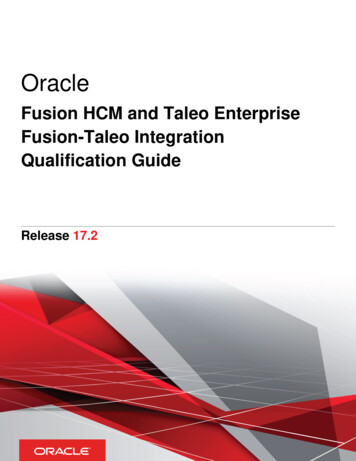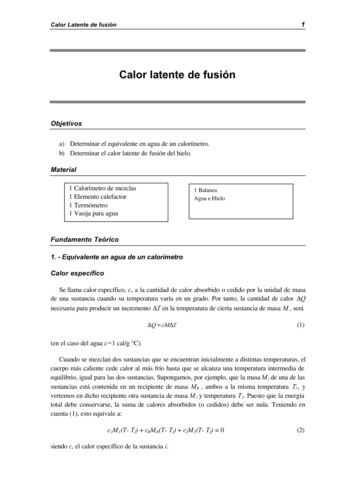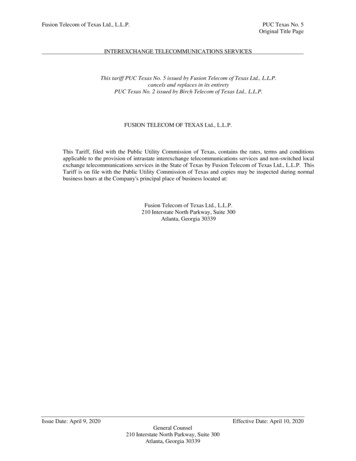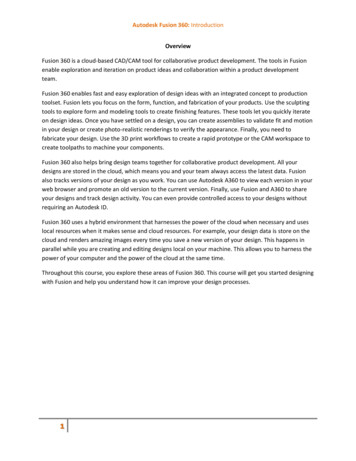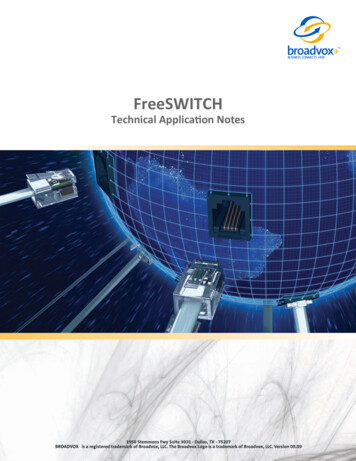
Transcription
FreeSWITCHTechnical Application Notes
Table of ContentsAbout FreeSWITCH . 1Purpose, Scope and Audience . 3FreeSWITCH Deployment Information . 4FreeSWITCH External IP Address . 4Sending Calls to Broadvox . 5SRV Records . 7Testing SRV Records . 7Preferred and Alternate Codecs . 9Is FreeSWITCH NATd . 9Is FreeSWITCH Behind a Firewall . 9Is There a Local Firewall . 9Configuring FreeSWITCH . 13Confidential and Proprietaryi
Confidential and Proprietaryii
About FreeSWITCHFreeSWITCH is an open source telephony platform designed to facilitatethe creation of voice and chat driven products scaling from a soft-phone upto a soft-switch. It can be used as a simple switching engine, a PBX, amedia gateway or a media server to host IVR applications using simplescripts or XML to control the call flow.FreeSWITCH supports various communication technologies such asSkype, SIP, H.323, IAX2 and GoogleTalk making it easy to interface withother open source PBX systems such as sipXecs, Call Weaver, Bayonne,YATE or Asterisk.FreeSWITCH supports many advanced SIP features such aspresence/BLF/SLA as well as TCP, TLS, and sRTP. It can also be used asa transparent proxy with and without media in the path to act as a SBC(session border controller) and proxy T.38 and other end to end protocols.FreeSWITCH supports both wide and narrow band codecs making it anideal solution to bridge legacy devices to the future. The voice channelsand the conference bridge module all can operate at 8, 16, 32 or 48kilohertz and can bridge channels of different rates.FreeSWITCH builds natively and runs standalone on several operatingsystems including Windows, Max OS X, Linux, BSD and Solaris on both 32and 64 bit platforms.The FreeSWITCH developers are heavily involved in open source and havedonated code and other resources to other telephony projects includingopenSER, sipXecs, The Asterisk Open Source PBX and Call Weaver.A Spec Sheet is available on the FreeSWITCH Wiki.For more information about FreeSWITCH, visit www.freeswitch.org.Confidential and Proprietary1
Confidential and Proprietary2
Purpose, Scope and AudienceThis technical application note describes the configuration of FreeSWITCHfor the Broadvox GO! SIP Trunking service on the Fusion platform. Thisdocument is suitable for use by anyone deploying the Broadvox GO! SIPTrunking service in conjunction with FreeSWITCH. This document has atechnical audience in mind – specifically IT professionals skilled in Linuxwith some experience in PBX administration and familiarity with VoIPtechnologies. This document is not for business administrators or people inother non-technical careers. In order to successfully use this document todeploy Broadvox GO! SIP Trunking service, you will need to possess thefollowing skills, or have access to professionals or consultants with thefollowing skills: Understanding of UNIX or Linux operating systems, including: Understanding of file and directory structure on target OS Understanding of firewall configuration on target OS Understanding of network configuration on target OS Understanding of service configuration on target OSFamiliarity with network troubleshooting tools, including: Wireshark/Ethereal dig/nslookup ping tracerouteFamiliarity with PBX systems, including: Trunk configuration Calling plan configuration Extension configuration Mailbox configurationFamiliarity with Session Initiation Protocol (SIP)An understanding of all seven layers of the Open SystemInterconnection (OSI) modelA complete understanding of your internal network structure,Network Address Translation (NAT) setup, and firewall setupA complete understanding of your public Internet connectivityBroadvox can only provide support for FreeSWITCH to the extent coveredin this Technical Application Note and the included reference configuration,so if your level of technical expertise does not include the above skills, it isrecommended that you obtain the services of an FreeSWITCHprofessional.Confidential and Proprietary3
FreeSWITCH Deployment InformationBefore you begin deploying FreeSWITCH, please locate the followinginformation. If you have questions about any item, refer to the descriptionsand additional details provided on the pages that follow.External IP Address or DNS:Preferred Codec: PCMUg729Alternate Codec: PCMUg729 noneIs FreeSWITCH NATd: YesNoIs FreeSWITCH Behind a Firewall: YesNoIs There a Local Firewall: YesNoFreeSWITCH External IP AddressYour FreeSWITCH server will either use a public IP address or a private IPaddress. If the IP address on your FreeSWITCH server is of the form192.168.x.x, 172.16.x.x – 172.31.x.x, or 10.x.x.x, then your FreeSWITCHserver uses an internal, private IP address. This internal address is notroutable on the public Internet. In order for your FreeSWITCH server toconnect to the Broadvox Session Border Controller, you must either have apublic IP address on your FreeSWITCH server or you must translate yourprivate IP address into a public IP address using a Network AddressTranslator (NAT).If your FreeSWITCH server is behind a NAT, your public IP address willtypically be the public IP address of your NAT. You may also have a static,one-to-one mapping of a public IP address to your private IP address. Inthis case, your public IP address will not match the IP address of your NAT,but you can look up the correct public IP address in your NAT configuration.If in doubt, you can perform a network packet capture using Wireshark(previously called Ethereal) on the public side of your NAT whilesimultaneously issuing some form of Internet request on your FreeSWITCHserver.Confidential and Proprietary4
Sending Calls to BroadvoxIn your Welcome letter, Broadvox provides DNS records to which you maysend calls, and from which you should be prepared to receive calls.FreeSWITCH supports DNS A records, DNS SRV records, and IPaddresses.At the top of your technical welcome letter, you will see a table like this onewhich shows your account number, turn-up ticket number, and trunknumber. This information should be provided to Broadvox when you call forassistance to expedite support.Figure 1: Welcome Letter Account InformationThe third page of the welcome letter contains a table of the IP addresses andports you need to allow through your firewall. Note that the table included here isan example and may be out of date. Please consult your actual welcome letter.Your firewall should be configured to accept signaling and media from these IPaddress and port combinations.Figure 2: Firewall Configuration InformationThe third page also contains the IP address and DNS information you should usefor configuring your trunk. Broadvox recommends you utilize the DNS A recordentries for FreeSWITCH unless you have specific reasons not to.Confidential and Proprietary5
Figure 3: Trunk Destination InformationAlso on the third page, you will find a section containing information about howyour trunk is configured on the Broadvox side. You should carefully review thisinformation to ensure it is configured properly.Figure 4: Configuration of Broadvox SideThe 'Admin E-mail ' lists the E-mail address which will receive alerts from theBroadvox SIP Trunking (Fusion) platform when various recognizable eventsoccur. These events include things such as calls being blocked because theywould cause you to exceed the simultaneous call sessions you purchased.FreeSWITCH has been tested to support TLS and SRTP with some moretechnically advanced configuration changes.Finally, on the fourth page, you will find two sections that specify how Broadvoxis configured to send calls to your FreeSWITCH box and how Broadvox isconfigured to receive calls from your FreeSWITCH box. These two sections areonly utilized if you provided static IP address information or DNS information.Broadvox can send calls to entirely separate systems from the ones it isconfigured to receive calls from. This allows you to split your inbound andoutbound traffic for any reason you may have, including but not limited to loaddistribution over several systems or multiple Internet connections. In addition,Broadvox can randomly load-balance calls across several systems using anidentical priority for the Send-To records. These options should allow you toengineer your traffic flow to suite your particular needs.Confidential and Proprietary6
Figure 5: Signaling ConfigurationSRV RecordsService records (SRV) are a form of Domain Name System (DNS) record. Theycontain information about where to send requests for a particular service offeredat a specific domain. In the case of Broadvox GO! SIP Trunking, they provide theIP addresses, port numbers, and preferences to use for sending SIP calls overUDP, TCP, and TLS to Broadvox. The SRV location to use for sending calls toBroadvox for each of your trunk groups is in your Welcome letter.Testing SRV RecordsMost Broadvox GO! SIP Trunking customers like to ensure the DNS entries arefunctioning or they like to look up the actual IP addresses. In a Windowsenvironment, you can perform the SRV query using the nslookup command at acommand prompt, as shown in Figure 1.Confidential and Proprietary7
Figure 6: SRV Lookup in Windows XPAs you can see, a SRV record consists of a service type definition ( sip), atransport definition ( udp), and the domain (nyc01-01.fs.broadvox.net).FreeSWITCH will automatically add the service and transport definitions as aprefix to the domain before performing the query. The query returns a priority,weight, port and hostname for each entry. The query also returns the “A record”entries for each hostname, which provides the IP address for each host.In a UNIX or Linux environment, you can perform a query on the Broadvox SRVrecords using the dig command: dig srv sip. udp.nyc01-01.fs.broadvox.net; DiG 9.3.4-P1 srv sip. udp.nyc01-01.fs.broadvox.net;; global options: printcmd;; Got answer:;; - HEADER - opcode: QUERY, status: NOERROR, id: 26443;; flags: qr rd ra; QUERY: 1, ANSWER: 1, AUTHORITY: 2, ADDITIONAL: 1;; QUESTION SECTION:; sip. udp.nyc01-01.fs.broadvox.net. IN SRV;; ANSWER SECTION:sip. udp.nyc01-01.fs.broadvox.net. 600 IN SRV01.fs.broadvox.net.10 0 5060 nyc01-;; AUTHORITY SECTION:fs.broadvox.net.fs.broadvox.net.600600;; ADDITIONAL SECTION:nyc01-01.fs.broadvox.net. 208.93.226.212;; Query time: 95 msec;; SERVER: 10.128.6.4#53(10.128.6.4)Confidential and Proprietary8
;; WHEN: Thu Jul 30 13:59:26 2009;; MSG SIZE rcvd: 150Preferred and Alternate CodecsBroadvox allows you to select preferred and alternate codecs to simultaneouslymeet your bandwidth requirements and provide greater end-to-end support. Inthe event that your destination party or your destination party’s carrier cannotsupport your preferred codec or alternate codecs, Broadvox will automaticallytranscode your call to a supported codec.When configuring codecs, please keep in mind that G.711 μLaw (PCMU)consumes approximately 87.2 Kbps of bandwidth per simultaneous call overEthernet. G.729 Annex A (g729) will consume approximately 31.2 Kbps ofbandwidth per simultaneous call over Ethernet. Also, keep in mind that G.711offers superior call quality when compared to G.729, but only if you have enoughbandwidth to support all of your simultaneous calls.Is FreeSWITCH NATdIf your FreeSWITCH server uses an Internet-facing IP address of the form192.168.x.x, 172.16.x.x – 172.31.x.x, or 10.x.x.x, then it is almost certainlybehind a Network Address Translation (NAT) device. If your server uses anaddress of that form and is not behind a NAT, then it has no connectivity to theInternet. Even if your server uses an IP address that does not match the formsabove, it is still possible (though very unlikely) that it is behind a NAT. IfFreeSWITCH is behind a NAT, you may need to perform port forwarding, set upa DMZ host or configure a one-to-one static IP map.Is FreeSWITCH Behind a FirewallIf FreeSWITCH is behind a NAT, then it is almost certainly behind a firewall. It isalso possible that FreeSWITCH uses a public IP address but is still behind afirewall. If you use a Cisco PIX, SonicWALL, Shorewall, Firebox, or any otherbrand of firewall, you may need to perform additional configuration steps on thefirewall device to allow FreeSWITCH to function properly. Additionally, you maybe using an Application Gateway such as an Ingate SIParator. These devices willalso need additional configuration to allow FreeSWITCH to function properly.Configuring your firewall or application gateway is beyond the scope of thisdocument. In general, you will need to allow UDP port 5060 in both directions, aswell as UDP ports 1024 to 65535 for RTP.Is There a Local FirewallIn addition to being behind a firewall, it is also possible that the FreeSWITCHserver itself utilizes a local firewall. Typically, FreeSWITCH is deployed on aConfidential and Proprietary9
UNIX or Linux operating system. These systems usually come with a firewallprogram installed, like iptables. If your server uses iptables, you can check tosee if there are any rules in place by issuing the following commands: iptables -L -v -nChain INPUT (policy ACCEPT 3549M packets, 4907G bytes)pkts bytes targetprot opt inoutsourcedestinationChain FORWARD (policy ACCEPT 0 packets, 0 bytes)pkts bytes targetprot opt inoutsourcedestinationChain OUTPUT (policy ACCEPT 688M packets, 51G bytes)pkts bytes targetprot opt inoutsourcedestination iptables -L -v -n -t natChain PREROUTING (policy ACCEPT 1836K packets, 118M bytes)pkts bytes targetprot opt inoutsourcedestinationChain POSTROUTING (policy ACCEPT 2247K packets, 136M bytes)pkts bytes targetprot opt inoutsourcedestinationChain OUTPUT (policy ACCEPT 2247K packets, 136M bytes)pkts bytes targetprot opt inoutsourcedestination iptables -L -v -n -t mangleChain PREROUTING (policy ACCEPT 3551M packets, 4907G bytes)pkts bytes targetprot opt inoutsourcedestinationChain INPUT (policy ACCEPT 3549M packets, 4907G bytes)pkts bytes targetprot opt inoutsourcedestinationChain FORWARD (policy ACCEPT 0 packets, 0 bytes)pkts bytes targetprot opt inoutsourcedestinationChain OUTPUT (policy ACCEPT 688M packets, 51G bytes)pkts bytes targetprot opt inoutsourcedestinationChain POSTROUTING (policy ACCEPT 688M packets, 51G bytes)pkts bytes targetprot opt inoutsourcedestinationThe output shown above indicates that there are no firewall rules configured onthis server. If you are using a different type of firewall software on yourFreeSWITCH server, you will need to consult the documentation for that softwareto learn how to check whether it is enabled. If you have a local firewall enabled,you will need to configure it to allow the appropriate ports, as described in “IsFreeSWITCH Behind a Firewall”.If you are using a standard iptables firewall setup, such as the one on Red HatEnterprise Linux, CentOS, Gentoo Linux, or Slackware Linux, these rules may beConfidential and Proprietary10
of use to you in allowing the appropriate traffic from the Broadvox Fusionplatform:# Allow SIP over UDP, TCP, and TLS:iptables -I INPUT -p udp --dport 5060 -s 208.93.224.224/28 -j ACCEPTiptables -I INPUT -p tcp --dport 5060 -s 208.93.224.224/28 -j ACCEPTiptables -I INPUT -p tcp --dport 5061 -s 208.93.224.224/28 -j ACCEPTiptables -I INPUT -p udp --dport 5060 -s 208.93.226.208/28 -j ACCEPTiptables -I INPUT -p tcp --dport 5060 -s 208.93.226.208/28 -j ACCEPTiptables -I INPUT -p tcp --dport 5061 -s 208.93.226.208/28 -j ACCEPTiptables -I INPUT -p udp --dport 5060 -s 208.93.227.208/28 -j ACCEPTiptables -I INPUT -p tcp --dport 5060 -s 208.93.227.208/28 -j ACCEPTiptables -I INPUT -p tcp --dport 5061 -s 208.93.227.208/28 -j ACCEPT# Allow media:iptables -I INPUT -p udp --dport 1024:65535 -s 208.93.224.224/28 -j ACCEPTiptables -I INPUT -p udp --dport 1024:65535 -s 208.93.226.208/28 -j ACCEPTiptables -I INPUT -p udp --dport 1024:65535 -s 208.93.227.208/28 -j ACCEPTiptables -I INPUT -p udp --dport 1024:65535 -s 64.158.162.71 -j ACCEPTiptables -I INPUT -p udp --dport 1024:65535 -s 64.158.162.100 -j ACCEPTiptables -I INPUT -p udp --dport 1024:65535 -s 64.152.60.71 -j ACCEPTiptables -I INPUT -p udp --dport 1024:65535 -s 64.152.60.164 -j ACCEPTiptables -I INPUT -p udp --dport 1024:65535 -s 209.249.3.71 -j ACCEPTiptables -I INPUT -p udp --dport 1024:65535 -s 209.249.3.81 -j ACCEPTiptables -I INPUT -p udp --dport 1024:65535 -s 64.156.174.71 -j ACCEPTiptables -I INPUT -p udp --dport 1024:65535 -s 208.93.227.5 -j ACCEPTiptables -I INPUT -p udp --dport 1024:65535 -s 208.93.226.5 -j ACCEPTPlease note you may not be able to copy and paste these directly into a terminalprogram like SecureCRT, PuTTY, ZOC, etc. You may need to paste intoNotepad or a similar text-only editor, and then copy and paste from there into theterminal program. This extra step should eliminate any hidden formattingcharacters that get copied along with the text (typically only applies whenperforming the copy and paste on a Microsoft platform).Any rules you insert into iptables must be loaded each time the FreeSWITCHserver restarts. There are typically two methods to accomplish this. The first (andusually preferred) method is to use the iptables save and restore functionality. Onmost platforms, you can simply issue one of these two commands:/etc/init.d/iptables save/etc/rc.d/iptables saveThe second method is to use a start-up script to re-issue the commands that addthe rules. Generally, you would create a file in /etc/init.d or the appropriate/etc/rc.d directory (based on your individual platform) that contains thecommands to create the rules. You would then chmod the file so that it isexecutable. Next, you would either create a symbolic link in the appropriate/etc/rc.d directory, or you would add it to your ‘local’ script which isresponsible for executing any custom start-up commands.Confidential and Proprietary11
If you require any further assistance in modifying your local firewall, pleaseconsult the documentation appropriate for your OS distribution and firewallprogram.Confidential and Proprietary12
Configuring FreeSWITCHPlease note that these configuration examples are presented only as aguide and do not constitute a complete FreeSWITCH configuration. Inaddition, they may contain errors or omissions.If you require additional assistance configuring FreeSWITCH, you may beable to obtain additional support using the FreeSWITCH IRC channel. TheFreeSWITCH developers, as well as many FreeSWITCH experts andconsultants, are available on the #freeswitch IRC channel onirc.freenode.net during normal business hours. The FreeSWITCHdevelopers also provide support contracts throughhttp://www.freeswitchsolutions.com/.After building and installing FreeSWITCH, you must configure it to use theBroadvox "Fusion" SIP Trunking platform. You will need to start by configuringyour Sofia SIP profile so that it will speak to the Broadvox Fusion platform usingthe correct protocols and options. This is a summary of the primary parametersthat need to be set on your SIP profile (on Linux, this is typically located in/usr/local/freeswitch/conf/sip profiles): profile name "broadvox" gateways X-PRE-PROCESS cmd "include" data "broadvox/*.xml"/ /gateways settings param name "context" value "broadvox-in"/ param name "rfc2833-pt" value "101"/ param name "codec-prefs" value "PCMU,G729"/ param name "inbound-codec-negotiation" value "greedy"/ param name "unregister-on-options-fail" value "true"/ param name "pass-rfc2833" value "true"/ param name "inbound-late-negotiation" value "true"/ param name "nonce-ttl" value "60"/ param name "auth-calls" value "false"/ param name "rtp-timeout-sec" value "300"/ param name "rtp-hold-timeout-sec" value "1800"/ param name "challenge-realm" value "auto from"/ param name "auto-rtp-bugs" data " SONUS SEND INVALID TIMESTAMP 2833"/ /settings /profile Please note that auto-rtp-bugs should be set to either "clear" or" SONUS SEND INVALID TIMESTAMP 2833". Both of these settings willdisable code that was added to FreeSWITCH to try to circumvent an old SonusDTMF issue. The version of code that Broadvox uses on the Broadvox coreSonus network does not suffer from the bug. Enabling the bug-fix code inFreeSWITCH will actually break DTMF interoperability between FreeSWITCHand the Broadvox Sonus core network. The bug was fixed by Sonus prior to April20th, 2008, but Broadvox does not have the exact date. Also, due to branching ofcode, some code branches released after that date are still believed to sufferfrom the bug. It is impossible to automatically determine whether you are sendingto a Sonus device that suffers from the bug, so there is no way that FreeSWITCHcan automatically determine whether to enable or disable the fix. However,Broadvox will guarantee that the current code on the Broadvox Sonus networkConfidential and Proprietary13
and all future code Broadvox deploys on the Broadvox Sonus network will notsuffer from the bug.After modifying your Sofia SIP profile, you must define gateways to the BroadvoxFusion platform for each city specified in your welcome letter. Start by making adirectory to hold the gateway information:cd /usr/local/freeswitch/conf/sip profilesmkdir broadvoxThen create an XML file for each city-based gateway:vim dfw01-01.fs.broadvox.net.xmlvim lax01-01.fs.broadvox.net.xmlvim nyc01-01.fs.broadvox.net.xmlThe contents of these files should look like this: !-- This is dfw01-01.fs.broadvox.net.xml -- include gateway name "dfw01-01" param name "username" value "your btn goes here"/ !-- param name "from-domain" value "your public ip or dns goes here"/ -- param name "password" value "your password goes here"/ param name "proxy" value "dfw01-01.fs.broadvox.net"/ !--/// expire in seconds: *optional* 3600, if blank ///-- !-- param name "expire-seconds" value "300"/ -- !--/// do not register ///-- param name "register" value "false"/ !-- param name "retry-seconds" value "30"/ -- param name "ping" value "25"/ /gateway /include !-- End of dfw01-01.fs.broadvox.net.xml -- !-- This is lax01-01.fs.broadvox.net.xml -- include gateway name "lax01-01" param name "username" value "your btn goes here"/ !-- param name "from-domain" value "your public ip or dns goes here"/ -- param name "password" value "your password goes here"/ param name "proxy" value "lax01-01.fs.broadvox.net"/ !--/// expire in seconds: *optional* 3600, if blank ///-- !-- param name "expire-seconds" value "300"/ -- !--/// do not register ///-- param name "register" value "false"/ !-- param name "retry-seconds" value "30"/ -- param name "ping" value "25"/ /gateway /include !-- End of lax01-01.fs.broadvox.net.xml -- !-- This is nyc01-01.fs.broadvox.net.xml -- include gateway name "nyc01-01" param name "username" value "your btn goes here"/ !-- param name "from-domain" value "your public ip or dns goes here"/ -- param name "password" value "your password goes here"/ param name "proxy" value "nyc01-01.fs.broadvox.net"/ !--/// expire in seconds: *optional* 3600, if blank ///-- !-- param name "expire-seconds" value "300"/ -- !--/// do not register ///-- param name "register" value "false"/ !-- param name "retry-seconds" value "30"/ -- param name "ping" value "25"/ /gateway /include !-- End of nyc01-01.fs.broadvox.net.xml -- Confidential and Proprietary14
If you are behind a NAT or have a dynamic, public IP address, you may wish toenable registration. Registration is not required, even under a NAT scenario or adynamic, public IP address scenario, but it is recommended. You may utilize adynamic DNS record to support a dynamic, public IP address. You may utilize astatic NAT or DMZ configuration on your firewall/NAT router to support a NATconfiguration. Alternatively, Broadvox provides stun.fs.broadvox.net if you preferto use STUN in a NAT configuration. Broadvox generally does not recommendthe use of STUN. The Broadvox switch will perform automatic NAT traversal if itdetects that you are behind a NAT. FreeSWITCH also has built-in NAT detectioncode through the UPnP or NAT-PMP functionality that may be built into your NATrouter.After configuring the gateways to Broadvox, you will need to configure yourdialplan to route DIDs from Broadvox to your extensions. You can do this bycreating a new XML file in your dialplan directory that provides a dialplan for the"broadvox-in" context:cd /usr/local/freeswitch/conf/dialplan/vim broadvox-in.xmlThe contents of the XML file would look something like this: include context name "broadvox-in" extension name "unloop" condition field " {unroll loops}" expression " true "/ condition field " {sip looped call}" expression " true " action application "deflect" data " {destination number}"/ /condition /extension !-Tag anything pass thru here as an outside call so you can make sure notto create any routing loops based on the conditions that it came fromthe outside of the switch.-- extension name "outside call" continue "true" condition action application "set" data "outside call true"/ /condition /extension extension name "call debug" continue "true" condition field " {call debug}" expression " true " break "never" action application "info"/ /condition /extension extension name "public extensions" condition field "destination number" expression " 5552345678 " action application "answer"/ action application "play and get digits" data "10 11 3 7000 # {sound prefix}/ivr/8000/ivr-enter ext pound.wav {sound prefix}/ivr/8000/ivrthat was an invalid entry.wav digits \d "/ action application "playback" data " {sound prefix}/ivr/8000/ivrthank you.wav"/ action application "playback" data " {sound prefix}/ivr/8000/ivrhold connect call.wav"/ action application "set" data "continue on fail true"/ action application "set" data "hangup after bridge true"/ action application "set" data "bypass media false"/ action application "set" data "proxy media true"/ action application "bridge" data "sofia/internal.domain.com/ {digits}"/ action application "playback" data " {sound prefix}/ivr/8000/ivrim sorry.wav"/ Confidential and Proprietary15
action application "playback" data " {sound prefix}/ivr/8000/ivrplease try again.wav"/ action application "respond" data "503"/ /condition /extension /context /include In this example, if the dialed DID matches 5552345678, the call is sent to a verybasic IVR that simply gathers an extension from the calling party. It will thenattempt to ring that extension on the internal Sofia SIP profile you haveconfigured (assuming that internal.domain.com is a domain mapped to thatinternal profile through an alias). When the call is connected, the media will betransparently proxied through the FreeSWITCH server. On modern hardware,you should be able to run hundreds (if not thousands) of calls through theFreeSWITCH server in this manner.This context will allow your DIDs to be routed to either specific users or tospecific IVR systems. Four outbound dialing, you need to set up a similar contextfor your phones. You may use the default contexts provided by FreeSWITCH andsimply customize them to suit your needs. When you finally need to bridge thecall to Broadvox, you may use this Sofia dial string: action application "set" data "continue on fail true"/ action application "set" data "originate timeout 2"/ action application "set" data "originate retries 1"/ action application "set" data "progress timeout 15"/ action applicat "bridge" data "sofia/gateway/dfw0101/ {destination number} sofia/gateway/nyc0101/ {destination number} sofia/gateway/lax01-01/ {destination number}"/ This dial string will attempt the number on the Dallas gateway first. If it fails forany reason, it will attempt the NYC gateway next. If that also fails, then it willattempt the LA gateway. The actions prior to the dial string instruct FreeSWITCHto allow 2 seconds for attempting each gateway with a maximum of one retrieson each gateway before hunting to the next. In addition, it will timeout the callattempt on a gateway if no ringing is received within 15 seconds of the gatewaynotifying you that the call is being attempted. While a gateway outage should beextremely rare, this will make any gateway outage completely transparent to you.You may, of course, order the gateways however you like.Confidential and Proprietary16
SIP Trunking, they provide the IP addresses, port numbers, and preferences to use for sending SIP calls over UDP, TCP, and TLS to Broadvox. The SRV location to use for sending calls to Broadvox for each of your trunk groups is in your Welcome letter. Testing SRV Records Most Broadvox GO! SIP Trunking customers like to ensure the DNS entries are

